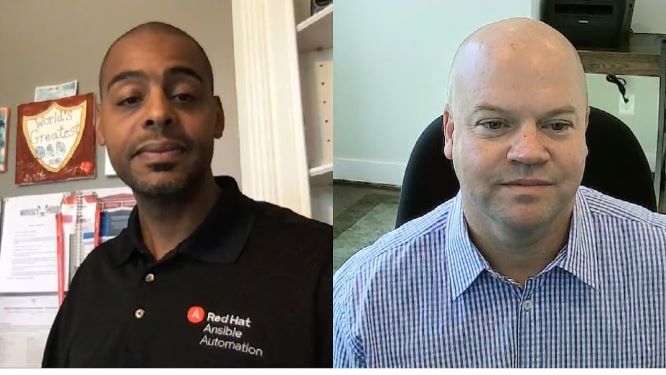 APPS
APPS
 APPS
APPS
 APPS
APPS
Automation is a major trend in most industries this year as cloud became the key operating model for businesses during 2020’s global pandemic.
And because automation brings agility and efficiency for business, it has gone “contagious,” which makes the scenario promising for vendors, according to Walter Bentley (pictured, left), senior manager of the automation practice at Red Hat Inc., parent company of the open-source automation platform Ansible.
“There are organizations that are picking up the automation adoption journey, and because of the momentum it creates inside of that organization, we’re finding [that] other municipalities that are associated with them are now also looking to be able to take on the journey because of that contagious nature,” Bentley said. “We’re really looking forward to being able to do more of it as the next quarter and the next year come up.”
Bentley and Jason Smith (pictured, right), vice president of North America consulting at Red Hat, spoke with John Furrier, host of theCUBE, SiliconANGLE Media’s livestreaming studio, during AnsibleFest 2020. They discussed the evolution of automation across enterprises, new business demands with the pandemic, how courses and certifications adapted to the online model, and the integrated offerings of Ansible and IBM. (* Disclosure below.)
By shaking the business world, the pandemic imposed new needs on companies, including in the automation environment. At the time of AnsibleFest last year, customers expressed the need to have a strategy on how to drive automation adoption in their companies, and it has now matured, according to Bentley.
“As we’ve gone over the past few months putting this in place with many customers, what we’ve learned is that many customers have matured into a place where they are now looking at the end-to-end workflow, instead of just looking at the tactical thing that they want to automate,” Bentley explained. “They are actually looking at the full ribbon, the full workflow and determining: ‘Are there changes that need to be made and adjusted to be more efficient when it comes to dealing with automation?’”
In this way, companies increased their expectations around automated processes and started to expect them to reduce operating costs, increase revenue, improve productivity and mitigate risks.
“Customers are up leveling what their expectations are out of the automation tools, and what I feel very confident about is that with the launch of the Ansible Automation Platform, we’re really able to deliver and show our customers how they’re able to get a return on their investment,” Bentley said.
While expecting more from automation, organizations are also much more selective about choosing their technology, according to Smith. They are not just looking for another tool, but for an automation platform that can leverage an enterprise-level strategy.
“And [they want] really to be able to make sure that they have something that’s secure, scalable and [that] they can use across the enterprise to be able to bring teams together and really drive value and productivity out of their automation platform,” Smith explained.
Another point considered valuable by companies on their automation path is the vendor’s experience with the process, as it helps to reduce implementation noise, according to Smith.
“Customers are really working with us because we’re working with the largest customers in the world to implement their strategies,” Smith stated. “So, they’re not having to learn that for the first time and figure it out on their own, but they’re really able to learn and leverage the experience we have through hundreds of customers and at enterprise scale.”
With the changes brought about by COVID-19, not only did automation offerings have to adapt, but consultings, trainings and certifications also had to be modified to support new requirements, such as remote delivery models.
Very quickly, in March, Red Hat was able to move its consultants to an online workforce and implement the tools and technologies needed to serve customers.
“We’ve been able to make a really seamless transition, and actually our CSAT Net Promoter Scores have actually gone up over the last six months or so,” Smith said.
The move was also successful for training and certifications, as everything is now provided remotely, he concluded.
Watch the complete video interview below, and be sure to check out more of SiliconANGLE’s and theCUBE’s coverage of AnsibleFest 2020. (* Disclosure: TheCUBE is a paid media partner for AnsibleFest 2020. Neither Red Hat Inc., the sponsor for theCUBE’s event coverage, nor other sponsors have editorial control over content on theCUBE or SiliconANGLE.)
THANK YOU